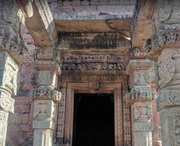Hindu Yogini temple in India
23°55′06″N 78°13′21″E / 23.9182813°N 78.2224866°E / 23.9182813; 78.2224866 (Gadarmal Devi Temple)| Architecture |
|---|
| Style | Pratihara, Māru-Gurjara |
|---|
| Creator | Pratihara dynasty |
|---|
| Date established | 8th to 9th century |
|---|
| Completed | 10th century |
|---|
| Temple(s) | 1 |
|---|
Gadarmal Devi temple is a Hindu and Jain temple at Badoh village of Vidisha, Madhya Pradesh. Also called Gadarmal Temple of the Mothers, it is one of India's yogini temples. It has 42 niches for yogini statues, unusually arranged in a rectangle; it must originally have been hypaethral.
Description
Gadarmal Devi temple dates back to the 9th century. The architecture of this yogini temple is a fusion of Pratihara and Parmara styles. It is built similar to Teli ka Mandir in Gwalior fort. This temple houses both Hindu and Jain idols. The temple is made of sandstone with seven small shrines surrounding the main shrine.
It is a 42-niche yogini temple. 18 broken images of the goddesses that once fitted into grooves in the temple platform are preserved from the waist down. It is composed of a rectangular shrine and a tall and massive Shikhara. Vidya Dehejia writes that as a yogini temple, it must once have been hypaethral, open to the sky. The temple was supposedly built by shepherds (gadariya), and is therefore called Gadarmal Devi Temple among locals. It consists of one oblong cell with an entrance porch but without sabhamandapa.[citation needed]
The archaeologist Joseph David Beglar photographed a colossal bas-relief sculpture of a mother and child inside the temple in 1871–2. He called it a figure of Maya Devi and the infant Buddha.[4]
See also
References
Sources
- Dehejia, Vidya (1986). Yogini Cult and Temples: A Tantric Tradition. National Museum, Janpath, New Delhi.
- Mitra, Swati (2012). Temples of Madhya Pradesh (1 ed.). Goodearth Publications. ISBN 978-9-3802-6249-9.
- "Gadarmal Temple". Archaeological Survey of India.
External links
- Photo-reportage of the temples on the site
|
|---|
|
Beginnings
(before
400 CE) | | Arts, sculpture | |
|---|
| Archaeological sites | |
|---|
| Inscriptions | |
|---|
| |
|---|
Maturity
(400-899 CE) | | Arts, sculpture | |
|---|
| Archaeological sites | |
|---|
| Inscriptions | |
|---|
| Temples | |
|---|
|
|---|
Advanced
(900-1299 CE) | |
|---|
Revival
(1400-1799 CE) | |
|---|
| Related | |
|---|
| Note: | - The above list of archaeological sites, inscriptions and temples is grossly incomplete.
|
|---|
|
 Idol of Vishnu
Idol of Vishnu A ceiling with Idols of Hindu goddesses
A ceiling with Idols of Hindu goddesses Doorway decorated with Hindu deities and human figures
Doorway decorated with Hindu deities and human figures





















